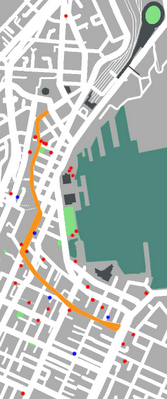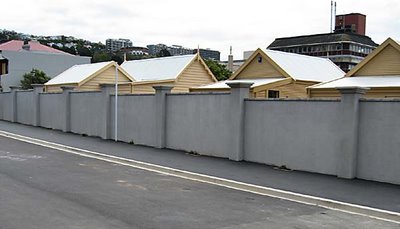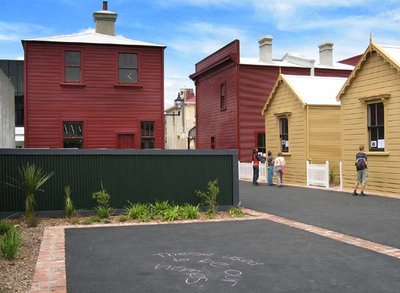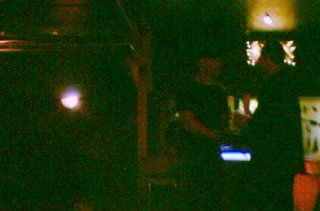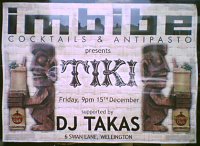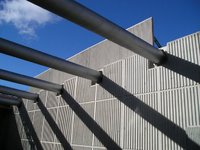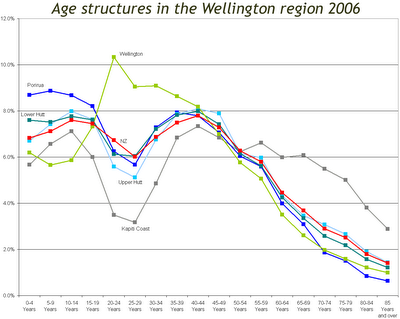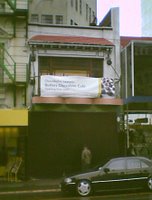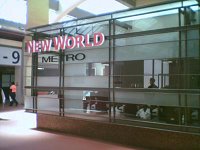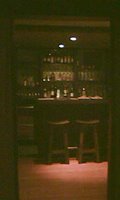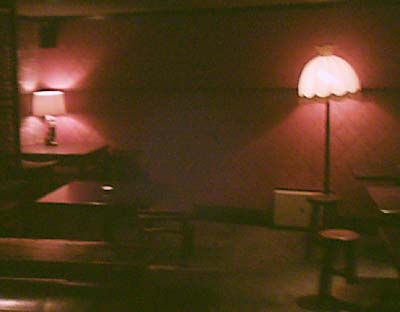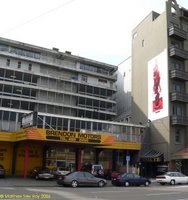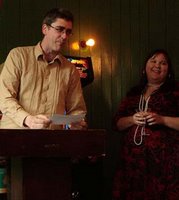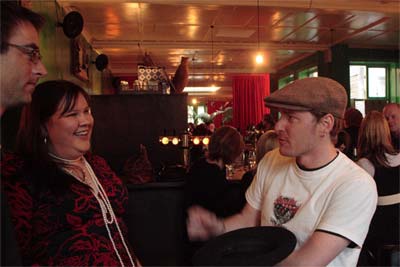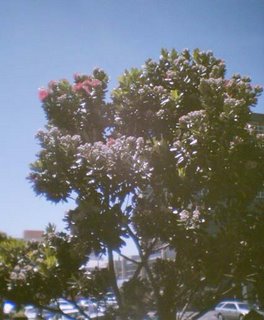I must be a sucker for punishment, since on Monday night I attended
the latest Waterfront Development Subcommittee meeting. Some people would consider that the study of local government consultation belongs under governance or public policy studies, but I've come to realise that it's a branch of psychopathology. The range of social dysfunction, paranoia and anger-management issues on display would fill several chapters of DSM-IV-TR: and that's just among the councillors. Those in the public gallery are worse, and I include myself as an obvious textbook example of chronic masochism.
Nevertheless, it's the only way to get the latest updates and gossip, which I've combined here with my usual other sources (public notices, real estate advertisements, unsubstantiated rumours, peering through windows) to update my
previous post on current and upcoming waterfront developments.
Waitangi Park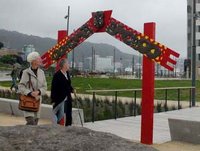
Waitangi Park is now officially finished. Well, it's been officially finished for a while, but now it's
even more finished. The waharoa (or should that be waharoa iti, given its somewhat diminutive height?) was
installed and blessed in October, and besides its spiritual and symbolic functions, it now provides a useful landmark. The final (
really final, this time) act will be to install some pou whenua prior to Waitangi Day, and while I haven't heard about where they're going to go, earlier renderings of the park showed some in the wetlands. Here's hoping that they use this opportunity to do something about the crappy blue pipes pouring the Waitangi stream into the wetlands: I have to believe that they were only an interim measure.
Chaffers DockA month ago I described the
confirmed tenants of the ground floor spaces, and while there have been no more announcements, it looks like the "sophisticated, relaxed dining" restaurant
Home will be in the desirable northwest corner of the building, and will be designed by
The House, who are responsible for the slick decor of
Matterhorn and
Mojo among others. Then again, they also created
Mighty Mighty, so anything could happen.
If you're worried about the cheap-looking vents that have been stuck all over the old building, you can relax: these are contrary to the scope, so the Technical Advisory Group is getting the contractors to replace them with something less obtrusive. The new
Boathouse apartments are looking great, and I can't wait until the complex opens (still no more detail beyond "after Christmas") to see how it transforms this section of the waterfront.
Overseas Passenger TerminalThere's little progress to report here, as Wellington Waterfront Ltd are
still negotiating with the Marina board over access to carparks. Let's hope they can come up with a solution that allows reasonable car access for berth owners without smothering the area in cars.
Taranaki Street WharfGoodbye, little green mound. While
some people really miss it, and
Jo will have to get a new banner for her not-blog, the flatter lawn should be a more flexible space, and it allows better views both to and from the Free Ambulance Building. This is still a temporary lawn, though, and while the final layout of this area is still being worked out (to accomodate the relocated wharewaka), it will probably get a bit more of a slope than it has now. The pohutukawa are gradually being installed in their final homes along the Quays, the timber garden is back in place, and with
St Johns looking like a big success it'll be good to see how the spaces work over summer.
It finally looks like
something is happening at the bottom of the NZX building. While the spaces were leased to Lion Breweries some time ago, and they didn't seem in too much of a hurry to sublet them, it appears that they are in discussions with a potential operator for one of the two spaces. Whatever it is (please be
a food market!), it's possibly going to open in the first quarter of next year.
Frank Kitts ParkThis was the main source of controversy at the meeting. Waterfront Watch were there in numbers, and as I didn't make an oral submission myself, all of the public presentations were against the Design Brief, and in particular the inclusion of a Chinese Garden here rather than at Waitangi Park. This was in contrast to
the written submissions (107kB PDF) which were primarily supportive of the move.
That didn't stop Waterfront Watch from claiming the moral high ground and brandishing a 12,000-signature petition that "proved" that the public were against the brief. In fact, the petition was from the 1990's, and was against putting multi-storey buildings along the park edge, and had nothing whatsoever to do with a Chinese Garden. Strangely, while they think that a Chinese Garden would be a wonderful public open space at Waitangi, at Frank Kitts it would "ruin the open space". They also continued to speak on behalf of "the Chinese Community", and it wasn't until the end of the meeting that an obvious yet inconvenient fact was pointed out to them: most of the submissions in favour of the change came from people with Chinese names!
While little extra detail was available (this is still a design brief, not a design, as some people couldn't get through their thick skulls), the Mayor hinted that the most likely location for the Garden would indeed be at the northern or western edges as
I speculated earlier. Also,
the recommendations (76kB PDF) stipulated that the design will be put out to an invited competition, with the finalists subject to public feedback and a jury decision. Good stuff.
Outer TAppeals against the
Hilton consent will go to the Environment Court in March or April next year. This is going to be a long process.
KumutotoDavid Irwin from Isthmus Group gave a short presentation on the revised master plan for the Kumutoto public spaces. These are going ahead quite rapidly now, with services laid and a contractor approved, and work is expected to start in January or February next year, ready for a Christmas '07 finish.
There are two significant changes from the plans that are still
shown online: the low jetties that were to have been added beside the promenade have been dropped, and the mouth of the Kumutoto stream has been modified. The former change is partly due to the desire not to overly "domesticate" the wharf, which makes sense since larger vessels would not have been able to dock at the low jetties, and it's good to keep some of the robust industrial feel of a working wharf. I can't quite agree with Irwin when he says that the current ones near Shed 5 are hardly used: I was there at lunchtime yesterday and all the benches were taken by people seeking a sheltered lunch spot. On the other hand, they make more sense in that spot, where the enclosure of the Outer T creates a more intimate scale, than immediately north of there where the tug wharf is more open.
In any case, the extra seating at the stream mouth should make up for it. This includes a cluster of north-facing platforms and jetties stepping down from
the Meridian building to the widened stream. Part of the tug wharf promenade will be replaced by a bridge (just slightly narrower than the existing promenade) to mark the stream mouth and create a sense of opening out towards the harbour. The bridge will be supported by a minimalist crane-like structure, partly for engineering reasons but mostly to create a vertical element as a marker along the harbourside promenade.
The Meridian building itself is proceeding rapidly, and looks set to open in September next year, which is earlier than I suggested before. There's still no confirmed tenant for the ground floor space, but Wellington Waterfront is actively negotiating with several potential tenants. It's possible that part of it might become a ticket office for the Eastbourne ferry, given its proximity to the new extended ferry wharf.
Waterloo Quay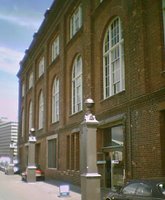
There's been a small but encouraging development in what has become the forgotten section of the waterfront between Whitmore St and the Railway Station. The ground floor of the old Shed 21 (now
Waterloo on Quay apartments) was always supposed to have been for retail, but its hitherto isolated location has made that difficult and the tenancies have ended up as offices or studios. That's changed just slightly, as
MADINZ, a corporate gifts specialist, has opened to the public.
Most of their business has come from government or diplomatic clients, but there's been enough public interest for them to start a quiet little retail operation. Interestingly, they say that they get a lot of business from the Statistics building up in
Harbour Quays, and they're expecting more from the new BNZ building when that's complete: a small demonstration of the fact that for retail to thrive on the waterfront, there needs to be people working nearby. Much of their predominantly New Zealand-made stock is quite touristy and available elsewhere, but they apparently have a significant discount, so it could be worth the journey.
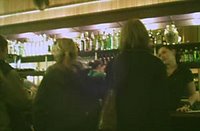 As anyone who frequents Cuba St should know, Plum has been undergoing renovations for a while. The old Plum had been well-liked (as these reviews attest), but was starting to feel a little tired: perhaps somewhere between the late Krazy Lounge and Mr Bun. I expected little more than a lick of paint and some new furniture, so it's a bit of a surprise to see it in its sleek new incarnation by Alistar Cox of Matterhorn, Mojo and Mighty Mighty fame. As the barman said, it's now pitched as something between a European-style café (with a much more relaxed attitude to alcohol than our original 90's cafés) and a proper bar. While Martinis weren't on offer (the barman said his Martini glasses were still at home!), with Tanqueray and Noilly on the moderately well-stocked shelves and apparently knowledgeable staff, the signs are good for the future.
As anyone who frequents Cuba St should know, Plum has been undergoing renovations for a while. The old Plum had been well-liked (as these reviews attest), but was starting to feel a little tired: perhaps somewhere between the late Krazy Lounge and Mr Bun. I expected little more than a lick of paint and some new furniture, so it's a bit of a surprise to see it in its sleek new incarnation by Alistar Cox of Matterhorn, Mojo and Mighty Mighty fame. As the barman said, it's now pitched as something between a European-style café (with a much more relaxed attitude to alcohol than our original 90's cafés) and a proper bar. While Martinis weren't on offer (the barman said his Martini glasses were still at home!), with Tanqueray and Noilly on the moderately well-stocked shelves and apparently knowledgeable staff, the signs are good for the future.
